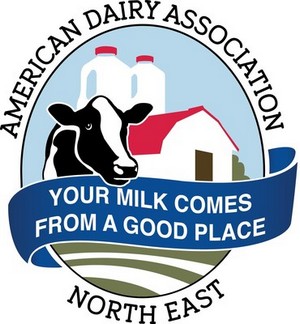While a heatwave continues to blaze across Pennsylvania conjuring up thoughts of fans, sprinklers and shades, most people may not realize these are the same tools employed by dairy farmers to keep their cows cool and comfortable during the warmer months.
 Cooling starts with the design of the barn to help regulate temperature and humidity. The barn structure itself provides shade and a comfortable place for cows to rest. “The barns in all of our facilities have features that help circulate air,” says Jenna Facer, Star Rock Farms, Conestoga, Pa. “The barn location was chosen to maximize wind flow. Inside, large propeller fans positioned above the cows move hot air away from them and the shades that make up the exterior walls can be opened and closed depending on the temperature.”
Cooling starts with the design of the barn to help regulate temperature and humidity. The barn structure itself provides shade and a comfortable place for cows to rest. “The barns in all of our facilities have features that help circulate air,” says Jenna Facer, Star Rock Farms, Conestoga, Pa. “The barn location was chosen to maximize wind flow. Inside, large propeller fans positioned above the cows move hot air away from them and the shades that make up the exterior walls can be opened and closed depending on the temperature.”
“When it is hot out, the barn is very comfortable. The fans create a nice breeze,” explains Mark Bradley, Bradley Dairy Farm, Sayre, Pa. who currently has 11 fans that create a 10-15 mph breeze throughout the barn. “When it gets uncomfortable outside for the cows during the day, I keep them in the barn, and they go out to pasture to graze at night.”
At Canon Dairy Farm in West Middlesex, Pa., owner Marie Canon says a mix of fans and sprinklers in the barn help keep her 110 cows cool. “For 28 years I threatened to hang hammocks in the feed allies for us to sleep in because the barn was way cooler than the house,” laughs Canon. Justin Risser of Meadow Vista Dairy in Bainbridge, Pa. understands that sentiment. “We have fans everywhere. Last count, we have 132 fans on the farm that cool and ventilate pens. 132!”
Sprinkler systems are automatically activated when the barn gets warm. Like lawn sprinklers only elevated, a series of pipes runs the length of the barn above the cows. Sprinkler heads disperse water in a 360-degree radius to provide an even spread of water across the pen. Once the cow’s skin is soaked, sprinklers are turned off to allow for evaporation, which is the process that removes heat from the cow.
Dairy farmers also limit the time cows spend out in the pasture during particularly hot weather. “Our cows only graze in the pasture in the early morning when it is the coolest,” says Canon. “They actually return to the barn on their own when the temperature gets to around 70 degrees.”
Staying hydrated is important too, so making sure cows have a sufficient supply of water is a priority. And sometimes farmers add a little something extra to ensure that hydration. “We provide an additional supply of water which includes electrolytes, alongside the fresh water reservoir for calves,” says Facer.
According to Canon, sprinklers come in handy during heatwaves and help keep cows cool and comfortable.
Facer explains, “Our cows have both fans and sprinklers. There are sprinklers over all our cows anywhere they might be congregated — feed troughs and while they wait to get milked, and fans throughout the entire pen, barn and even in the holding pen and milking parlor, creating a constant breeze. Keeping the sprinklers isolated to one area allows the pens to stay dry and clean.”
When cows relax, Risser’s method for keeping them comfortable is a sand bed. He says, “We use recycled sand year-round on our dairy. The sand is mildly damp when it goes into the stalls in the summer so it’s cool to lay down on.” At Star Rock, Facer says, “We use more sawdust in our bedding to help keep our beds extra dry which is especially important during humid weather.”
Cow care is a priority for dairy farmers all year round as it directly affects milk quality and cow health. A variety of methods can be employed to make sure cows are content, particularly during these hotter months. “I decide to do what I do based on the constant desire to make the cows as comfortable as possible,” says Bradley. “I watch them, and always look for ways to make them more comfortable.”
Source: American Dairy Association North East




